 | 







 |  |

 |  |  | 

By Rob Irving
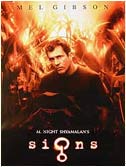 Every summer, as England's wheat fields become canvases for the popular
oeuvre of land art that is 'crop circles', the nation's newspapers feature
the prettiest pattern to date and shroud it in mystery. 2002 held the added
value of a Hollywood movie on the subject - 'Signs' starring Mel Gibson (pictured right).
Even Mel reckons that the patterns can't all be explained by pranksters with
boards and string. He hastened to add, though, that this doesn't mean he
believes in ET. Every summer, as England's wheat fields become canvases for the popular
oeuvre of land art that is 'crop circles', the nation's newspapers feature
the prettiest pattern to date and shroud it in mystery. 2002 held the added
value of a Hollywood movie on the subject - 'Signs' starring Mel Gibson (pictured right).
Even Mel reckons that the patterns can't all be explained by pranksters with
boards and string. He hastened to add, though, that this doesn't mean he
believes in ET.
July's pin-up (pictured below) fitted neatly between Bronze Age burial mounds at Stonehenge.
The Daily Mail's feature quoted photographer/enthusiast Steve Alexander
hinting at a link with ancient sacred sites. And besides, insisted Steve,
without a hint of irony, "they are far too precise to have been done in the
dark overnight, and if there is anyone talented enough to do that then I for
one would like to meet them."
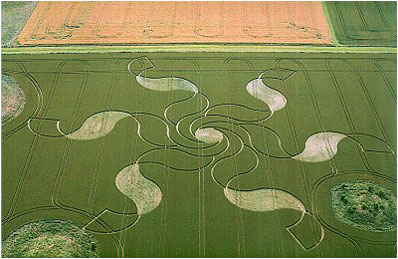
With apt circularity, each year at summer's end the emphasis shifts from
sanctifying the patterns to debunking them, as the same newspapers compete
to hire known circle-makers to make one that is geometrically complex
enough - the current criteria for genuineness - to fool an unwitting expert.
(A short note on 'experts': as no-one is yet able to satisfactorily tell a
non-man-made crop pattern from any other the title is moot, usually self- or
media-conferred. And on 'genuineness': While most of us ascribe the term to
mean something of known, identifiable origin, to cerealogists it describes
the opposite - it is a verification of mystery. an unknown. Cerealogy is a
culture where common language, usually a guarantee of meaning, becomes a
useful means of misinterpretation.)
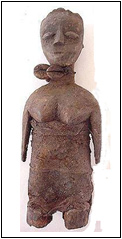 The anthropologist Preston Blier observed of West African Vodun sculpture (pictured rght) -
though the same would apply to all religio-magical art, including crop
patterns - that it can be viewed independently on various levels; that we
can read the work from the multiple perspectives of the artist who makes it,
the producer who embellishes and empowers it, the users and audiences who
interact with it, and the 'cultural spokespersons' (diviners, priests,
pseudo-scientists, alchemists, magicians etc) who guard the information on
these objects. The anthropologist Preston Blier observed of West African Vodun sculpture (pictured rght) -
though the same would apply to all religio-magical art, including crop
patterns - that it can be viewed independently on various levels; that we
can read the work from the multiple perspectives of the artist who makes it,
the producer who embellishes and empowers it, the users and audiences who
interact with it, and the 'cultural spokespersons' (diviners, priests,
pseudo-scientists, alchemists, magicians etc) who guard the information on
these objects.
According to Blier, 'the most salient features of these artworks are the
powerful human emotions they evoke, their potency is a manifestation of
their psychological power to disorientate, disturb and grip the imagination;
force, fear, fury, shock, disorder and deception play critical roles in
their reception and use.'
Inasmuch as there is a general belief that something supernatural is behind
the patterns, cerealogy fits the standard definition of religion. Even those
who create the patterns have learned to comfortably co-exist with those who
pursue it as a non-man-made phenomenon in a mutual exchange of
interpretative interplay, bound by the greater good of our interaction with
the unknown. At this frontier, art is paraded as science and science
masquerades as art.
The patterns themselves are not the only ritual object. To avoid charges of
subjectivity, experienced cerealogists channel their judgement through a
variety of tools and measuring devices. These are used in much the same way
as an oracle, and with all the confidence of a shaman with a ju-ju. Just as
the camera and photography were once seen to be immune from subjectivity, so
any tool can be assumed to provide a non-interventionist objectivity - a
truth - over human fallibility. The story of electrical equipment failing in
and around crop patterns carries weight with believers because such 'tools'
are sensitive, precision instruments and therefore eliminate bias. Likewise,
in the right hands, dowsing rods, pendulums and an assortment of 'black box'
devices. (Alternatively, the tool is an extension and enhancement of the
human body, magnifying our subjectivity through interpretation - photography
and dowsing being obvious examples.)
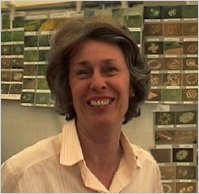 Lucy Pringle, (pictured right) founder of the Unexplained Phenomenon Research Society of
Petersfield, Hants, buries bottles of water in crop patterns, measuring the
resultant energy resonance by dowsing (counting pendulum oscillations).
These findings are confirmed by carefully monitoring 'delta activity'
(intuition). Pringle also compares the nitrate/nitrogen levels in the soil.
I'm not sure I understand why she does this and I'm less confident of her
ability to explain it, but on the strength of this research she can assure
the populace (via the Daily Mail) she has a verifiable scientific method for
determining genuineness. Lucy Pringle, (pictured right) founder of the Unexplained Phenomenon Research Society of
Petersfield, Hants, buries bottles of water in crop patterns, measuring the
resultant energy resonance by dowsing (counting pendulum oscillations).
These findings are confirmed by carefully monitoring 'delta activity'
(intuition). Pringle also compares the nitrate/nitrogen levels in the soil.
I'm not sure I understand why she does this and I'm less confident of her
ability to explain it, but on the strength of this research she can assure
the populace (via the Daily Mail) she has a verifiable scientific method for
determining genuineness.
What resonates most strongly here is a paradoxical post-rationalist echo of
science; by mimicking orthodox methodology Pringle clearly wants to emulate
it. Whether this is for her own comfort or for effect, what emerges is a
classic occultist tendency to think the whole world hangs together by the
unification of one's self.
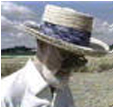 Higher up the scientistic scale, if only by training, and eclipsing even
Pringle in arrogance are Drs WC 'Lefty' Levengood and Eltjo Hasselhof. Each
has a flair for producing relatively convincing scholastyle papers whilst
completely lacking common sense¹. Hasselhof believes that the patterns are
made by balls of light (BOLs) emitting electromagnetic radiation. He
substantiates the link by measuring the proportional increase in the length
of nodes on wheat-stalks, from which data he is able to pin-point the
position of the BOL at the moment of the pattern's creation. He answers
criticism that his (and Levengood's) methods are not filtered through
blind-testing by dismissing this notion as "meaningless and time-consuming".
"A good researcher is not affected by a priori knowledge" he says. Higher up the scientistic scale, if only by training, and eclipsing even
Pringle in arrogance are Drs WC 'Lefty' Levengood and Eltjo Hasselhof. Each
has a flair for producing relatively convincing scholastyle papers whilst
completely lacking common sense¹. Hasselhof believes that the patterns are
made by balls of light (BOLs) emitting electromagnetic radiation. He
substantiates the link by measuring the proportional increase in the length
of nodes on wheat-stalks, from which data he is able to pin-point the
position of the BOL at the moment of the pattern's creation. He answers
criticism that his (and Levengood's) methods are not filtered through
blind-testing by dismissing this notion as "meaningless and time-consuming".
"A good researcher is not affected by a priori knowledge" he says.
Interestingly, after more than a decade of study biophysicist WC Levengood
has only recently noticed that the characteristic 'anomalies' (primarily
lengthened nodes) of genuine crop patterns are also to be found in
wind-damaged or 'lodged' crop. This would appear to negate Hasselhof's
assertions, as it implies that there is nothing unusual in flattened crop
displaying subtle physiological changes due to, say, phototropism or trauma.
But with impressive illogic Levengood and his followers assert the precisely
opposite: rather, the same supernatural force that makes the patterns also
flattens indiscriminately, and what we would dismiss as weather-damage may
be something mysterious.
So much for Occam's razor, but to compare this to a purely honest quest for
knowledge using actual facts is to miss the point. To the outside world
there is no real secret to the patterns' provenance. The science of
cerealogy could really be as simple as discreetly mimicking (hoaxing) a
pattern and observing how this generates the same effects and claims as the
'genuine' article. Only a fool would subsequently favour vague and
apocryphal, low-grade evidence over a practical demonstration. But, here,
truth is relative and answers are invariably obscured by 'blind eye'
insulation from outright recognition, as if the spell will be broken by
discovery. Tapping the totem to determine that it consists only of wood
leaves little of value. It is just as human to want to prolong the
delightful sense of not knowing, and there is no shortage of hucksters who
profit from feeding it. In the mystery business, the truth may be out there
but the key to discovery is in never really finding it.
NB: Soon after this article was published, researcher Kevin Randle
questioned 'Dr' Levengood's academic credentials: contrary to Lefty's
assertions his "PhD equivalent" had not come from the US National Academy of
Sciences, who apparently make no such awards.
Photos: Steve Alexander, Peter Sorensen.
|  |  |   | |













